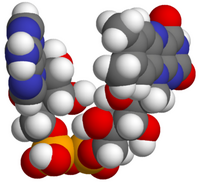
Photo from wikipedia
The flavin‐dependent enzyme 2‐haloacrylate hydratase (2‐HAH) catalyzes the conversion of 2‐chloroacrylate, a major component in the manufacture of acrylic polymers, to pyruvate. The enzyme was expressed in Escherichia coli, purified,… Click to show full abstract
The flavin‐dependent enzyme 2‐haloacrylate hydratase (2‐HAH) catalyzes the conversion of 2‐chloroacrylate, a major component in the manufacture of acrylic polymers, to pyruvate. The enzyme was expressed in Escherichia coli, purified, and characterized. 2‐HAH was shown to be monomeric in solution and contained a non‐covalent, yet tightly bound, flavin adenine dinucleotide (FAD). Although the catalyzed reaction was redox‐neutral, 2‐HAH was active only in the reduced state. A covalent flavin‐substrate intermediate, consistent with the flavin‐acrylate iminium ion, was trapped with cyanoborohydride and characterized by mass spectrometry. Small‐angle X‐ray scattering was consistent with 2‐HAH belonging to the succinate dehydrogenase/fumarate reductase family of flavoproteins. These studies establish 2‐HAH as a novel noncanonical flavoenzyme.
Journal Title: ChemBioChem
Year Published: 2018
Link to full text (if available)
Share on Social Media: Sign Up to like & get
recommendations!